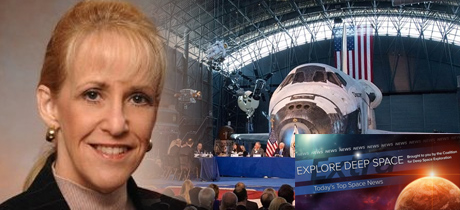In Today’s Deep Space Extra… The White House National Space Council convenes for the second time on today at NASA’s Kennedy Space Center. The Space Council named a 29 member advisory panel Tuesday night. Astronauts could step to the surface of the moon in the late 2020’s, according to Robert Lightfoot, NASA’s acting administrator. Bigelow Aerospace unveiled plans Tuesday for an in depth look at the global commercial and government market for a commercial successor to the International Space Station.
Human Space Exploration
Lightfoot: First crew return to lunar surface towards end of the next decade
Spacepolicyonline.com (2/20): Robert Lightfoot, NASA’s acting administrator, placed the time frame for astronauts stepping to the surface of the moon again at late in the 2020’s during a Washington gathering hosted by the Space Transportation Association. Their transportation to the surface from the U.S. led Lunar Orbital Platform-Gateway (LOPG), a lunar orbiting human habitat outlined in NASA’s proposed 2019 budget, could be commercial, government or furnished by an international partner. The same could be true of the astronauts themselves. Lightfoot spoke on the eve of today’s meeting of the recently re-established National Space Council, chaired by Vice President Mike Pence and scheduled for NASA’s Kennedy Space Center at 10 a.m., EST.
White House announces members of National Space Council User’s Advisory Group
Coalition in the News – The Boeing Company, Lockheed Martin, Northrop Grumman, Orbital ATK, United Launch Alliance and Coalition President and CEO
Spacepolicyonline.com (2/20): The advisory group’s 29 men and women, all from outside of NASA but with policy making, industry, science and spaceflight backgrounds, will provide counsel to the re-established National Space Council, chaired by Vice President Mike Pence. The lineup, which includes Coalition President and CEO Mary Lynne Dittmar, was announced late Tuesday, the eve of the space council’s NASA Kennedy Space Center gathering. The session, which gets underway at 10 a.m., EST, is to be web cast (www.nasa.gov/nasalive).
Will the ISS continue beyond 2024
Spaceflightinsider.com (2/20): It seems likely the NASA led International Space Station, continuously inhabited for nearly 18 years, will survive beyond 2025, the time frame in which the White House proposes that NASA’s direct involvement come to an end so the agency can transition its focus to human deep space exploration. But the prospect for a commercial formula for doing so seems unclear. The Station is currently operated under a cooperative agreement involving 15 nations and five major space agencies.
Goodbye, ISS. Hello, private space stations?
Coalition Member in the News – Axiom Space
Planetary Society (2/20): If the NASA led International Space Station is to transition to a U.S. commercial led model in 2025, two companies, Bigelow Aerospace and Axiom, could be among those leading the way forward to a challenging transition. Both companies have proposals to dock commercial modules at the space station, then separate them to become the nucleus of a commercial orbital outpost with government space agencies among the customers.
Space Science
This is exactly the wrong time to retreat from space
Washington Post (2/20): The nation stands at a quite promising and exciting time for space science. That’s why it makes no sense for the U.S. to turn its back on the WFIRST dark energy observatory, writes physicist Tom Rosenbaum, president of Cal Tech, and Edward Stone, former director of NASA’s Jet Propulsion Laboratory, in a letter to the editor. Released last week, the Trump Administration’s 2019 budget proposal would terminate development of the technically challenging WFIRST.
Op-ed: In Defense of Astrophysics
Space News (2/20): Jon Morse, a former head of NASA’s astrophysics divisions, offers a strong defense for not cancelling NASA’s WFIRST dark energy space observatory and trimming the agency’s astrophysics budget, as proposed in the 2019 fiscal year budget now before Congress. “From the Hubble Space Telescope, arguably the greatest space science mission of all time, to the transformational Kepler planet-hunting telescope, NASA’s astrophysics missions have rewritten textbooks and inspired millions,” writes Morse.
Astronomers observe the rotating accretion disk around the supermassive Black Hole in M77
Universe Today (2/20): Japanese astronomers have succeeded in intricately imaging an expansive disk of dust and gas swirling around a super massive black hole about 47 million light years from the Earth using Chile’s Atacama Large Millimeter/submillimeter Array.
Other News
Bigelow Aerospace establishes space operations company to look at commercial space station market
Space News (2/20): Bigelow Space Operation Company, of Las Vegas, previewed plans Tuesday to conduct a yearlong, in depth assessment of the global government as well as commercial interest in financially supporting commercial low Earth orbit human space activities if the U.S. was to end direct NASA involvement in the 15 nation International Space Station.
NASA deal may see Australian company build Mars rover
ABC.net of Australia (2/20): Australia’s Gilmore Space Technologies has struck an agreement with NASA to test a Mars rover at the Kennedy Space Center. The testing could advance efforts with the rover to demonstrate the extraction of water from the red planet’s soil.
SpaceX has an intriguing launch on Wednesday morning
Ars Technica (2/20): SpaceX will attempt to demonstrate the recovery of the payload fairing from a Falcon 9 rocket scheduled to liftoff from Vandenberg Air Force Base, California today. The primary payload is a commercial Spanish earth observations satellite.

